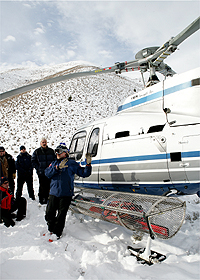Sun Valley Heli Ski guides practiced wrapping packages this week they hope they never have to deliver.
Loading an EVAC-U-SPLINT, otherwise known as a "bean bag" and a backboard, into pilot Lon Stickney's Aerospatiale A-Star 350 helicopter, the team of professional ski guides was preparing to respond to winter backcountry emergencies. New this year, the 40th anniversary of the Ketchum company, the guides and Stickney are training with local emergency first responders to coordinate rescue efforts when the A-Star is the best tool for the incident.
Every year about 150 Life Flight trips are made from the Wood River Valley to Boise hospitals for medical emergencies. Those trips typically commence from the controlled environment of the St. Luke's Wood River Medical Center roof, a parking lot or a field. However, emergencies in the backcountry sometimes require a slightly different approach, which more than once has come in the form of help from Stickney and guides Pete Patterson, Bozo Cardozo and Eric Leidecker.
On Tuesday, emergency first responders joined the guides and Stickney for a helicopter rescue training session that oriented people to the French-made helicopter that brought skier Steve Waltcher to safety and advance care after he was seriously injured in an avalanche on Titus Ridge in March.
Gleaning lessons learned from the mountain rescue performed in challenging weather conditions, Stickney said the ship is an important tool in the area's arsenal of rescue services and that it was finally time to orient would-be rescuers to safe activity around the whirling blades of a helicopter.
"The neat thing about Life Flight is that you can join and they will pay what insurance doesn't," said Blair Boand, captain of the Sun Valley Fire Department, a ski patroller and a member of the Sun Valley City Council, who has seen his fair share of life-saving helicopter flights out of the valley. Boand said it was always safer to land a helicopter in the Sun Valley Gun Club parking lot than to stage a flight near the cramped space around the old Moritz Hospital in Sun Valley Village.
Speaking to a group of about two dozen first responders from several fire departments and members of the Galena Backcountry Ski Patrol, Leidecker explained how a helicopter takes off and lands. He stressed the importance of establishing a safe landing zone, including adequate main and tail rotor clearance both for the machine and people on the ground.
Leidecker said in order to establish a landing zone for pilots, rescuers on the ground need to think about wind speed and direction, ground cover and debris and slope angle.
"The general rule of thumb is to establish safe zones with the helicopter," Leidecker said, as Stickney came in for a landing near the end of the plowed portion of Trail Creek Road, blowing up a cloud of snow. The group shielded their faces until Stickney shut the whirlybird down.
Pete Patterson said it is key to keep track of belongings and objects that can get blown into the rotors.
"I love hats because they slice and dice," he said, adding that Murphy's Law says that loose objects will get sucked into the rotor wash.
Patterson said protocol is to drag skis by their tips when approaching a helicopter, where often in the backcountry pilots dare not to shut down due to unpredictable weather conditions or snowpack.
Stickney, in his third season with Sun Valley Heli Ski, said the A-Star is the best helicopter for the sport of heli-skiing and that every year improvements have been made in the company's understanding of how to use it also as a rescue tool.
Stickney added that a rule of thumb for the leader on the ground is to always have eye contact with the pilot. Doing so helps the pilot know that human activity is under control so that he can focus on operating the machine in variable conditions. And, due to the noise and rotor wash of the machine, verbal communication is difficult at best.
Cardozo explained that for rescuers on the ground, the going can be tough if the snow is deep. Preparing a solid landing zone may take a long time, as it did during Waltcher's rescue, but it is key to a successful evacuation to the hospital.


 Sun Valley Heli Ski owner Mark Baumgartner introduces emergency professionals to the Aerospatiale A-Star 350 helicopter and its application as a backcountry rescue tool.
Sun Valley Heli Ski pilot Lon Stickney dropped out of the sky Tuesday near the end of the plowed portion of Trail Creek Road for an in-service training for emergency first responders to learn how to use the tool for mountain rescue operations. Photo by Chris Pilaro
Sun Valley Heli Ski owner Mark Baumgartner introduces emergency professionals to the Aerospatiale A-Star 350 helicopter and its application as a backcountry rescue tool.
Sun Valley Heli Ski pilot Lon Stickney dropped out of the sky Tuesday near the end of the plowed portion of Trail Creek Road for an in-service training for emergency first responders to learn how to use the tool for mountain rescue operations. Photo by Chris Pilaro



































